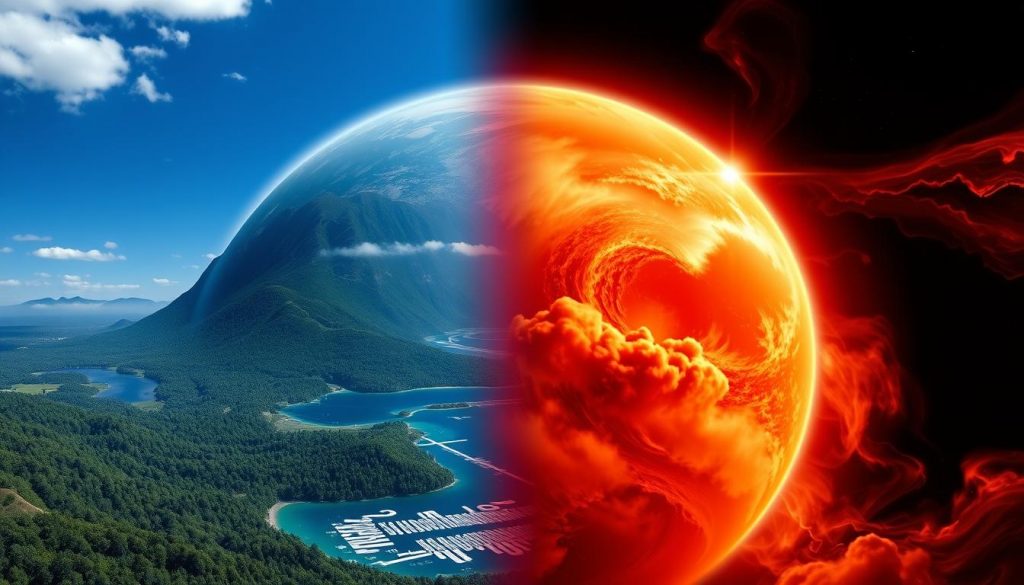Venus’ Extreme Climate: Lessons for Earth
Venus is often called Earth’s twin. It helps us understand the Venus climate and its changes. The surface of Venus is incredibly hot, about 467°C. This extreme heat shows how a planet can change from being possibly habitable to a very hostile place.
Anúncios
The atmosphere on Venus is incredibly dense, about 92 times Earth’s. This extreme climate warns us about the dangers to Earth’s environment. It teaches us important climate change lessons that we must learn.
Historical data shows Venus might have had liquid water in the past. This challenges our ideas about what makes a planet habitable. As we face climate change on Earth, studying Venus helps us understand the dangers of neglecting our environment. It shows us how crucial it is to protect our planet’s atmosphere.
The Intriguing Mystery of Venus’ Atmosphere
Venus is unique in our solar system with its thick, toxic atmosphere. It’s mostly carbon dioxide, with pressure 92 times Earth’s. The atmosphere also has dense sulfuric acid clouds, making the surface extremely hot, over 462 degrees Celsius (864 degrees Fahrenheit).
Scientists once thought Venus could support life. It might have had a shallow ocean for up to 2 billion years. But now, it’s a hot, hostile world. Studying its atmosphere and geology could teach us about greenhouse gas effects and climate change.
Missions like NASA’s DAVINCI are exploring Venus’ atmosphere. They use advanced spectrometers to study the planet’s climate history. This research could reveal how greenhouse gases changed Venus.
| Feature | Venus | Earth |
|---|---|---|
| Atmospheric Composition | 96.5% CO2, 3.5% N2, traces of other gases | 78% N2, 21% O2, 0.04% CO2 |
| Surface Temperature | Over 462 °C (864 °F) | Approximately 15 °C (59 °F) |
| Atmospheric Pressure | About 90 times that of Earth | 1x (Standard atmospheric pressure) |
| Cloud Composition | Sulfuric acid | Water vapor |
| Cloud Altitude | 48-68 km above surface | 12-15 km above sea level |
Exploring Venus helps us understand climate changes. It shows how important studying atmospheres is in astrobiology and climate science. The search for clues in Venus’ history is ongoing. It could teach us about habitability and sustainability in other worlds.
Understanding the Extreme Climate of Venus
Scientists call Venus and Earth planetary siblings because they are similar in size and makeup. But, their distance from the Sun makes them very different. Venus is much closer to the Sun, about 67 million miles away. This close distance is key to its extreme climate.
Venus has a runaway greenhouse effect. Its atmosphere is mostly carbon dioxide, trapping a lot of heat. The surface temperature is around 900 degrees Fahrenheit, making it the hottest planet. Sometimes, it even gets hotter than 1,000°F.
Winds on Venus can be as fast as 224 mph, causing extreme weather. This is because its atmosphere moves much faster than the planet itself. This leads to intense storms and changes in the climate.
Temperatures also change with altitude. For example, 30 miles up, it can be between 86 and 158 degrees Fahrenheit. These changes show how complex Venus’s climate is. It’s a fascinating area for scientists to study.
Why Study Venus Climate? Lessons from Its Past
The extreme conditions on Venus offer key insights into atmospheric science and climate change. A study of Venus’s history shows how it changed from a possibly temperate world with oceans. This change makes us think about Earth’s climate future.
Venus’s atmosphere is very dense, mostly carbon dioxide, making it hotter than 600°K. This heat is enough to melt lead. Venus teaches us that small climate changes can lead to big effects. Michael Hart’s work from the 1970s shows Earth is close to being too hot or too cold.
Volcanic activity and climate changes on Venus are linked. Big eruptions might have changed Venus’s climate, like Earth’s mass extinctions. This connection shows why studying Venus is important for understanding Earth’s climate.

How Venus Went from Habitable to Hellish
Venus changed from a possible home for life to a scorching hot world. It once had oceans and temperatures that could support life for about two billion years. Simulations show it had stable temperatures between 68 and 122 degrees Fahrenheit.
The sun’s light and Venus’s atmosphere changed the planet’s climate. An old sun was 30 percent dimmer, keeping Venus cool. But as the sun got brighter, Venus’s atmosphere got thicker, mainly from water vapor. This created a cycle that made the planet even hotter.
Today, Venus’s surface is a sizzling 864 degrees Fahrenheit, with pressure 90 times Earth’s. Volcanoes also played a big role in Venus’s climate change. A huge volcanic event 700 million years ago released lots of carbon dioxide, making the planet even hotter.
The atmosphere’s change was another key factor. It shifted from mostly nitrogen to mostly carbon dioxide. This change made Venus’s conditions deadly.
Studying Venus teaches us about the delicate balance of our planets. It shows how changes in the sun and geology can affect a planet’s ability to support life.
Venus Climate: The Catastrophic Greenhouse Effect
The greenhouse effect on Venus is a clear example of extreme climate change. The surface temperature of Venus is about 450°C, much hotter than Mercury. This high heat is mainly because of its atmosphere, which is mostly carbon dioxide.
This dense atmosphere, nearly 90 times thicker than Earth’s, is key to Venus’s runaway greenhouse effect.
Venus shows how climate change can happen fast. Scientists think Venus’s climate turned hellish less than a billion years ago. Studying Venus helps us understand Earth’s climate challenges.
Volcanic activity, like large igneous provinces, might have changed Venus’s atmosphere. This is similar to what could happen on Earth.
The climate on Venus warns us. If Earth had back-to-back super-eruptions like the Siberian Traps, greenhouse gases could rise a lot. This shows why we need to watch volcanic activity and its effects on Earth’s climate.
In summary, studying Venus’s greenhouse effect is crucial. It shows the importance of the atmosphere and the need for balance to keep Earth habitable.
Key Differences Between Earth and Venus
Exploring the planetary differences between Earth and Venus gives us insights into their unique climates. Both planets are similar in size and composition. Yet, their atmospheres are vastly different. Venus’ atmosphere is mostly carbon dioxide, unlike Earth’s mix of oxygen and nitrogen.
This difference in atmosphere makes Venus’ surface extremely hot, reaching 900 degrees Fahrenheit (482 degrees Celsius). Earth’s atmosphere, on the other hand, is cooler and more balanced.
The climate comparison also shows that Venus takes about 225 Earth days to complete one year. However, a day on Venus lasts about 243 Earth days. This unusual rotation affects Venus’ weather, causing extreme conditions.
Every four days, Venus experiences massive atmospheric tsunamis and hurricane-force winds. This is due to its slow rotation period.
Another key difference is the pressure in their atmospheres. Venus’ surface pressure is 90 times greater than Earth’s. This is like being at a depth of 3,000 feet (900 meters) under Earth’s oceans. This extreme pressure highlights the importance of atmosphere in shaping a planet’s climate.

| Feature | Earth | Venus |
|---|---|---|
| Diameter | 12,756.3 km | 12,103.6 km |
| Mass | 5.972 x 10²⁴ kg | 4.869 x 10²⁴ kg |
| Atmospheric Composition | 21% Oxygen, 77% Nitrogen | 96% Carbon Dioxide, 3% Nitrogen |
| Surface Temperature | Average around 59 degrees Fahrenheit | 900 degrees Fahrenheit (482 degrees Celsius) |
| Surface Pressure | 1 atm | 90 atm |
| Rotation Period | 23 hours 56 minutes | 243 Earth days |
| Orbital Period | 365.25 days | 224.7 days |
These differences highlight not just the planetary differences but also offer insights for climate research.
Scientific Missions to Understanding Venus’ Climate
Exploring Venus is key in space research, with over 40 missions launched to study its climate. The European Space Agency’s Venus Express played a big role from 2005 to 2014. It focused on the atmosphere, including sulfur dioxide and sulfuric acid clouds.
NASA’s Mariner 2 was the first to reach Venus in 1962. The USSR’s Venera series had 17 successful missions. Venera 3 was the first to land on Venus in 1965, and Venera 4 did it first in 1967. Pioneer Venus 1, launched in 1978, was the first orbiter.
NASA’s Magellan mission in 1989 gave us detailed images of Venus. Future NASA missions like VERITAS and DAVINCI will launch in the 2030s. They will work with ESA’s Envision to study Venus in depth.
These missions help scientists understand Venus’ climate. This knowledge helps us learn about Venus and Earth. Each mission adds more details about Venus’ atmosphere and geology, keeping scientists interested.
Lessons Learned for Earth’s Climate Change
The extreme conditions on Venus teach us important climate change lessons for the Earth climate. Its surface temperature is a scorching 462 degrees Celsius. This shows what happens when global warming is not stopped.
Venus’s atmosphere is incredibly dense, about 92 times Earth’s. This makes its environment almost like hell. Scientists believe Venus once had a shallow ocean and could have supported life for up to 2 billion years.
This shows how fragile life is and how bad increased carbon emissions can be. Today, Venus’s atmosphere is mostly carbon dioxide, showing how severe greenhouse gas buildup can be.
Learning from Venus helps us understand Earth’s future. Its climate history warns us about the dangers of a runaway greenhouse effect. This is caused by rising carbon levels.
Similar volcanic activity on Earth, like during ‘The Great Dying,’ also shows the dangers of greenhouse gas emissions. These emissions can cause big temperature increases.
By studying Venus, scientists can better predict Earth’s climate. The habitable zone around stars is very narrow. This means small changes in the atmosphere can cause big climate shifts. This knowledge is crucial as we face the effects of global warming.
Conclusion
The study of Venus’ extreme climate gives us key insights into the dangers of climate change. Today, Venus’ surface is almost as hot as the sun, and its atmosphere is incredibly thick. This shows us what can happen if a planet’s climate gets out of balance.
By studying Venus, we learn more about Earth’s environment and how to keep it healthy. Venus could have been a home for life for hundreds of millions of years. But it changed into a hostile place just 715 million years ago.
This change highlights the need to understand our planet better. With ongoing research, like NASA’s DAVINCI mission, we’re learning more about Venus and Earth’s connection. This knowledge could help us avoid a similar fate for our planet.
In short, studying Venus helps us understand climate science and why we need to take care of Earth. As we face climate challenges today, Venus teaches us the importance of acting now. Learning from Venus reminds us of our duty to protect Earth for future generations.
